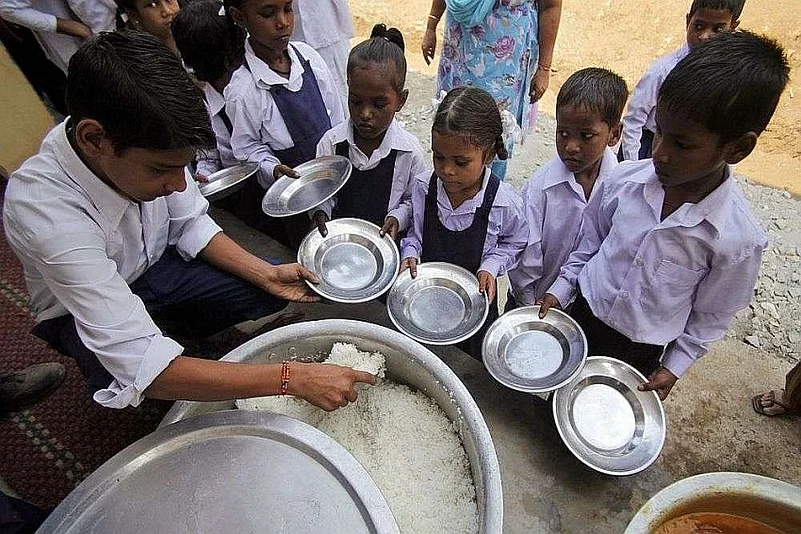India’s greatest national treasure is our children. We cannot afford to neglect their wellbeing and allow so many of our children to face malnutrition. Zero hunger and good nutrition have the potential to transform and empower the present and future generations.
Malnutrition (deficiency or excess of nutrients in a diet) remains a major threat to the survival, growth and development of children. Undernutrition (deficiency of nutrients i.e. calories, proteins, carbohydrates, vitamins or minerals in a diet) is most prevalent in India.
The Mid-day Meal Scheme is a school meal programme designed to ameliorate the nutritional status of school-age children nationwide. The programme supplies free lunches on working days for children in primary and upper primary classes in government, government aided, local body, Education Guarantee Scheme, and alternate innovative education centres, Madarsa and Maqtabs supported under Sarva Shikha Abhiyan, and National Child Labour Project schools run by the ministry of labour. Serving 120,000,000 children in over 1,265,000 schools and Education Guarantee Scheme centres, it is the largest of its kind in the world.
Advertisement
Also Read| Why Reviving Midday Meals Is A Must
India is not just fighting undernutrition but is also battling COVID 19 outbreak in the country. Together, we are facing a truly unprecedented situation. The global coronavirus pandemic is affecting our families, work, communities, and the way of life. The world has seen outbreaks, with some worse than others, but one thing is common, all these outbreaks result in loss of life and are global health & nutrition crisis.
The schools are closed due to the COVID 19 pandemic and apart from education, the Mid-Day Meal program has been severely hit. According to a recent report by the UNICEF on food insecurity and nutrition around the world, recent pandemic is adding 83-132 million people undernourished in 2020.
UNICEF data suggests that on an average 370 million children may miss on nutritious school meals.
Advertisement
Meanwhile, the nutritional status of vulnerable population would further go down. Children and families relying on these programs are further being pushed to hunger and poverty. Food programs should be thus, more flexible keeping well in mind the rules and regulations of encouraging social distancing and other hygiene practices. In India, the situation is more demeaning. Since March, schools are closed in India following the safety protocols. This has also affected the routine of mid-day meal care program altogether.
The spread of COVID-19 has impacted the health, nutrition, livelihoods and wellbeing of India's most vulnerable populations and will have lasting effects on people. We can understand that the possible impact could be an increase in child malnutrition, child labour, early marriage, trafficking, school dropout rate, dilution of MDM among other family members etc.
Also, reduction in the number of meals per day and hence the quantity of food per meal as well. Ensuring diet diversity at the time of COVID also remains a challenge as the main goal during this health crisis and lockdown is availability of the basic food first. Therefore, quality of the diet is also compromised.
In some parts of the country, following measures have been taken at local level and the same can be replicated in other places.
-Community kitchen for preparing food like nutritious khichdi (rice, daal, green vegetables and oil). Saraswati Vahini members andSelf-Help Groups (SHGs)members are involved in the same. Teachers are playing a role to monitor the quantity, quality and hygiene factors and the supply of stocks. The distribution is being done through tola wise volunteers/SHG volunteers.
Advertisement
-Since schools are not running, nutrition and WASH education are being focused upon by using mobile services. It is used to educate the children on nutritional diet, using local food resources, like the concept of Tiranga Bhojan
-Messages are being spread over mobiles, jingles over phone and other such mediums so that they reach the children. TV/Radio are also being used.
-Ensuring weekly supply of IFA tablets during the MDM home deliveries
-Teachersidentify a cadre of older children from higher classes from the school who can be volunteers for the different tolas. The Involvement of communities and the civil society organisations including SHGs in a strategic manner can bring desired nutrition outcomes. It was also felt that good governance and accountability are important factors in successfully improving nutrition among the children.
Advertisement
( Author is the executive director of Coalition for Food and Nutrition Security (CFNS) )




















